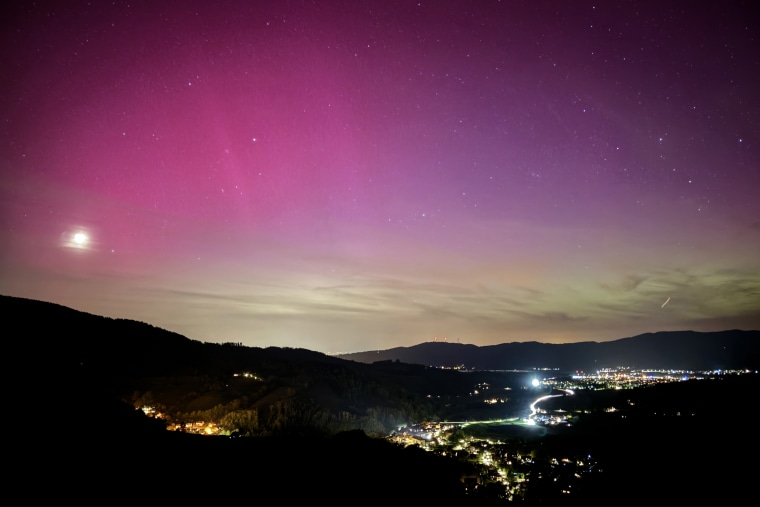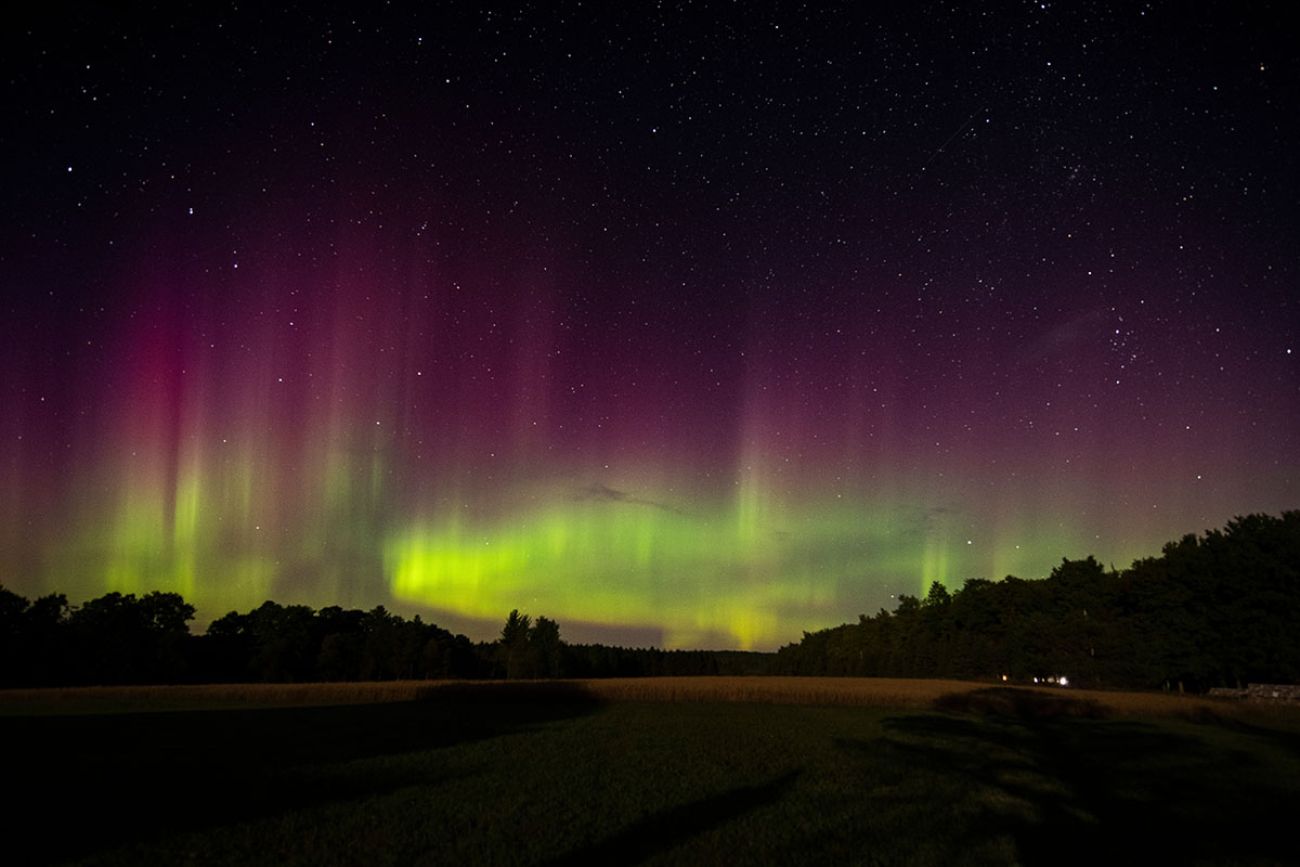Solar Flares Can Create Light Northern Auroras: A Dazzling Display
- Update Time : Saturday, October 5, 2024

Solar flares can trigger stunning Northern Auroras, visible as light displays. These natural light shows are most visible near the poles.
Solar flares are powerful bursts of radiation from the sun that can have dramatic effects on Earth. One of the most beautiful outcomes is the creation of Northern Auroras, also known as the Northern Lights. These captivating phenomena occur when charged particles from the sun collide with Earth’s magnetic field and atmosphere.
This celestial event often manifests as a dance of light across the sky, with colors ranging from green to purple. The best places to witness this natural wonder are at high latitudes, near the Arctic and Antarctic regions. Enthusiasts and travelers seek out these areas for a chance to experience the ethereal glow of auroras, which can illuminate the night sky with an otherworldly beauty. Solar activity plays a crucial role in the intensity and frequency of Northern Auroras, making solar flares a key factor in their occurrence.
The Science Behind Solar Flares
The Science Behind Solar Flares reveals how our Sun’s dramatic activity can lead to stunning light displays on Earth. Understanding this cosmic phenomenon starts with grasping what solar flares are and the magnetic intricacies of the Sun.
What Are Solar Flares?
Solar flares are sudden eruptions of energy on the Sun’s surface. They release vast amounts of light, heat, and particles into space. These flares can impact Earth, creating beautiful auroras and, sometimes, disrupting technology.
The Sun’s Magnetic Activity
The Sun’s surface is a hub of magnetic activity. Magnetic fields twist and tangle over time. When they snap, they release energy as solar flares. These events are linked to sunspots, which are cooler areas on the Sun caused by magnetic activity.
Coronal Mass Ejections (CMEs) often accompany solar flares. CMEs send billions of tons of solar particles into space. When these particles collide with Earth’s magnetic field, they can spark northern lights, known as auroras.
| Solar Event | Effect on Earth |
|---|---|
| Solar Flares | Auroras, Tech Disruptions |
| CMEs | Enhanced Auroras |
Scientists monitor the Sun using satellites like the Solar Dynamics Observatory (SDO). This helps predict solar flares and protect our technology.

Credit: www.nbcnews.com
Journey Of Solar Flares To Earth
The solar flare’s journey to Earth is a thrilling adventure. These fiery eruptions travel through space to create beautiful lights in our sky. Let’s explore how this happens.
Ejection From The Sun
Solar flares start on the Sun’s surface. They are huge bursts of energy. Imagine the Sun throwing a giant fireball into space. That’s what happens during a solar flare. This fireball travels towards Earth at high speed.
Interaction With Earth’s Magnetic Field
When solar flares reach Earth, they meet our magnetic field. This invisible shield protects us. The solar energy dances with the magnetic field. This dance creates stunning lights in the sky, known as auroras.
- Solar flares leave the Sun.
- They travel through space.
- Earth’s magnetic field catches them.
- Beautiful auroras light up the sky.
This journey from the Sun to Earth shows nature’s incredible power. It brings us the gift of northern lights. These lights remind us of the wonders of our universe.
The Formation Of Northern Auroras
The Formation of Northern Auroras is a magnificent display. The sky lights up with a dance of colors. This show happens near the Earth’s poles. Solar flares are the main actors in this natural drama.
Ionization Of Atmospheric Gases
Solar flares send charged particles towards Earth. These particles hit the atmosphere. They collide with gases like oxygen and nitrogen. This process is called ionization. Ionization makes the sky glow. It creates the beautiful auroras we see.
- Charged particles travel from the sun.
- They collide with Earth’s atmosphere.
- Oxygen and nitrogen gases get ionized.
- The sky lights up with color.
Color Variations In Auroras
Different gases make different colors. Oxygen can glow green or red. Nitrogen can make blue or purple light. The type of gas and altitude determine the colors. This is why auroras are so colorful.
| Gas | Color | Altitude (km) |
|---|---|---|
| Oxygen | Green/Red | 100-300 |
| Nitrogen | Blue/Purple | 100-400 |
Each color tells us about the gas and its height. This is why the aurora is never the same. It is always a new, stunning show.
Visual Splendor Of Light Northern Auroras
The sky dances with light when solar flares strike Earth’s atmosphere. These natural light shows are the Northern Auroras. Colors burst through the night sky, creating a spectacle of light and movement. This visual splendor is a must-see phenomenon.
Auroras Beyond The Arctic
Solar flares can push Northern Lights beyond their usual Arctic scope. Places far from the poles might witness the glow. This makes the auroras accessible to more people. Here are some regions where auroras appear:
- Northern United States
- Parts of Western Europe
- New Zealand and southern Australia
Photographing The Northern Lights
Capturing the Northern Lights is an art. The right gear and settings make a difference. Use these tips for the best photos:
| Tip | Details |
|---|---|
| Camera | Use a DSLR or mirrorless camera with manual mode. |
| Lens | Wide-angle lens with a large aperture (f/2.8 or lower). |
| Tripod | Keeps your camera steady for long exposures. |
| Settings | Manual focus, long exposure (5-30 seconds), ISO 800-3200. |
Predicting Aurora Displays
Predicting Aurora Displays is both exciting and complex. Scientists study the sun to guess when auroras might happen. This helps us know the best time to see these beautiful lights in the sky.
Solar Activity Forecasting
The sun goes through cycles of activity. During high activity, we see more auroras. Experts use data from satellites to predict these cycles. This helps us know when we might see an aurora.
- Sunspots give clues about solar flares.
- Solar flares can cause auroras.
- Predictions help us plan for the best viewing times.
Tools For Aurora Chasers
Many tools help us chase auroras. These tools use data to guess when and where auroras will appear.
- Aurora Forecast Apps: These apps tell us when to expect auroras.
- Solar Wind Monitors: These tools watch for solar wind that can cause auroras.
- Photography Guides: Guides help us capture the beauty of auroras with cameras.
Together, these tools and forecasts make chasing auroras easier and more fun.

Credit: www.post-gazette.com
Impact Of Solar Flares On Technology
The sun’s fiery outbursts, known as solar flares, can dazzle us with beautiful northern auroras. Yet, these natural light shows can disrupt technology we rely on every day. Let’s explore how solar flares impact our tech-driven world.
Effects On Satellite Communications
Solar flares can disturb satellite operations. These disruptions affect TV, internet, and GPS services. Satellites exposed to intense radiation may malfunction or degrade. Companies often switch to backup systems during solar events to maintain services.
- GPS navigation may lose accuracy.
- TV signals could experience interference.
- Communication satellites face signal delays.
Mitigating Geomagnetic Storms
Preventing solar storm damage is crucial. Space agencies and operators use early warnings from satellites to protect technology.
- Monitor solar activity for potential threats.
- Shift satellites to ‘safe mode’ during solar storms.
- Plan spacecraft orbits to minimize exposure.
Advanced materials and tech designs also shield satellites from harmful effects. These measures ensure our tech infrastructure remains resilient against solar flare impacts.
Solar Flares In Cultural Context
Solar flares have long captured human imagination. These spectacular events trigger bright northern auroras. Cultures worldwide weave stories and art around them. Let’s explore how solar flares influence myths and the arts.
Myths And Legends
Solar flares and auroras are steeped in folklore. They often represent powerful deities or omens. Cultures interpret these celestial displays through unique lenses, creating a rich tapestry of myths.
- In Norse mythology, auroras were the glowing armor of the Valkyries.
- Native American tales describe auroras as the dance of spirits.
- In Baltic regions, they were believed to be the pathway of souls.
Inspirations In Art And Literature
Auroras and solar flares have inspired artists and writers. The vibrant colors and patterns show up in many creative works. They symbolize beauty, mystery, and the power of nature.
| Work | Artist/Author | Representation |
|---|---|---|
| The Starry Night | Van Gogh | Aurora-like swirls in the sky |
| Northern Lights | Philip Pullman | Auroras as a gateway to other worlds |
| Aurora Leigh | Elizabeth Barrett Browning | Named after the aurora’s beauty |

Credit: www.bridgemi.com
Future Research And Exploration
As we gaze into the night sky, solar flares and their impact on northern auroras remain a spectacular mystery. Ongoing studies and future missions are critical for our understanding. With new technology, we can expect to unravel these cosmic phenomena further.
Advancements In Solar Observations
Scientists continually develop tools to observe the sun. Telescopes on Earth and in space capture solar flare events. These tools provide data to predict when auroras might occur.
- Solar Dynamics Observatory (SDO) watches the sun constantly.
- Parker Solar Probe travels closer to the sun than any prior mission.
- European Solar Telescope (EST) will give new insights soon.
Studying Auroras From Space
Spacecraft observe auroras directly. They help us understand the connection between solar flares and magnetic fields. Upcoming missions will provide more detail on this interaction.
| Mission | Focus | Launch Date |
|---|---|---|
| AuroraSAT | Auroras’ structure | 2025 |
| ICON | Ionosphere and auroras | Active |
| ARASE | Particles in auroras | Active |
These missions will illuminate the dance between solar flares and the Earth’s atmosphere. The resulting auroras will be studied like never before. The future is bright for aurora research and exploration.
Frequently Asked Questions
What Causes The Northern Auroras?
Solar flares emit charged particles that interact with Earth’s magnetic field, creating the colorful displays known as auroras. These particles collide with atmospheric gases, producing vivid lights predominantly near the poles.
Can Solar Flares Affect Earth’s Technology?
Yes, intense solar flares can disrupt satellite communications, GPS signals, and power grids due to the high-energy particles they release into space, which can interact with electronic systems on Earth.
How Often Do Solar Flares Occur?
Solar flares happen frequently, with smaller flares occurring several times a day. Larger, more disruptive flares are less common, occurring about once every 11 years during the solar maximum.
Are Northern Auroras Predictable?
While the occurrence of auroras is linked to solar activity, predicting their exact time and location can be challenging. However, space weather forecasts can provide estimates on when conditions are favorable.
Conclusion
Solar flares illuminate the sky with breathtaking northern auroras, merging science and beauty. Embracing this natural phenomenon enriches our understanding of the universe. Witnessing these lights reminds us of Earth’s connection to the cosmic dance. Let’s cherish and seek out these magical displays, a testament to nature’s wonder.


















Leave a Reply